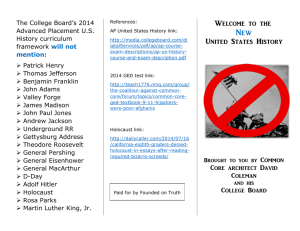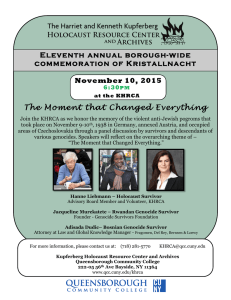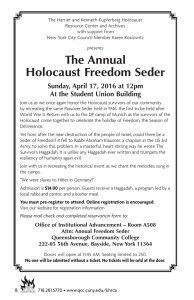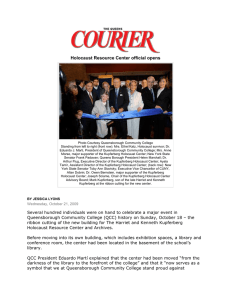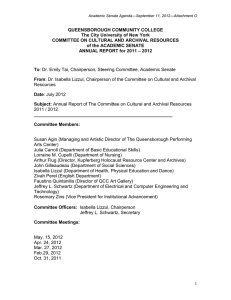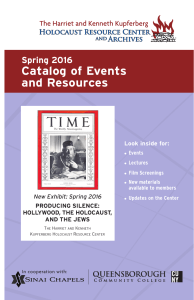Hearts Open At QCC Holocaust Center
advertisement
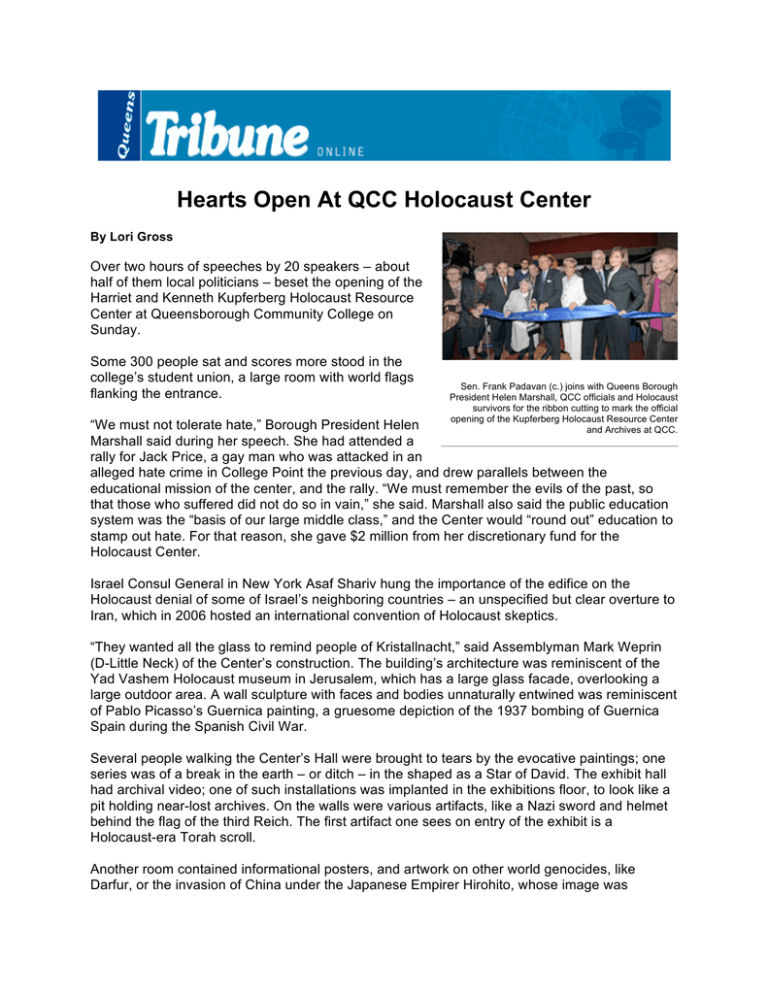
Hearts Open At QCC Holocaust Center By Lori Gross Over two hours of speeches by 20 speakers – about half of them local politicians – beset the opening of the Harriet and Kenneth Kupferberg Holocaust Resource Center at Queensborough Community College on Sunday. Some 300 people sat and scores more stood in the college’s student union, a large room with world flags flanking the entrance. Sen. Frank Padavan (c.) joins with Queens Borough President Helen Marshall, QCC officials and Holocaust survivors for the ribbon cutting to mark the official opening of the Kupferberg Holocaust Resource Center and Archives at QCC. “We must not tolerate hate,” Borough President Helen Marshall said during her speech. She had attended a rally for Jack Price, a gay man who was attacked in an alleged hate crime in College Point the previous day, and drew parallels between the educational mission of the center, and the rally. “We must remember the evils of the past, so that those who suffered did not do so in vain,” she said. Marshall also said the public education system was the “basis of our large middle class,” and the Center would “round out” education to stamp out hate. For that reason, she gave $2 million from her discretionary fund for the Holocaust Center. Israel Consul General in New York Asaf Shariv hung the importance of the edifice on the Holocaust denial of some of Israel’s neighboring countries – an unspecified but clear overture to Iran, which in 2006 hosted an international convention of Holocaust skeptics. “They wanted all the glass to remind people of Kristallnacht,” said Assemblyman Mark Weprin (D-Little Neck) of the Center’s construction. The building’s architecture was reminiscent of the Yad Vashem Holocaust museum in Jerusalem, which has a large glass facade, overlooking a large outdoor area. A wall sculpture with faces and bodies unnaturally entwined was reminiscent of Pablo Picasso’s Guernica painting, a gruesome depiction of the 1937 bombing of Guernica Spain during the Spanish Civil War. Several people walking the Center’s Hall were brought to tears by the evocative paintings; one series was of a break in the earth – or ditch – in the shaped as a Star of David. The exhibit hall had archival video; one of such installations was implanted in the exhibitions floor, to look like a pit holding near-lost archives. On the walls were various artifacts, like a Nazi sword and helmet behind the flag of the third Reich. The first artifact one sees on entry of the exhibit is a Holocaust-era Torah scroll. Another room contained informational posters, and artwork on other world genocides, like Darfur, or the invasion of China under the Japanese Empirer Hirohito, whose image was holographically projected onto a set of several large knives in a piece of artwork which had been imported from Japan. Assemblyman Mark Weprin (D-Little Neck), Councilman David Weprin (D-Hollis), and State Sen. Frank Padavan (R-Bellerose) each gave $1.5 million from their discretionary funds for the building, along with major private donors Harriet and Kenneth Kupferberg. Councilmen Jim Gennaro (D-Fresh Meadows), John Liu (D-Flushing) and Helen Sears (D-Jackson Heights), Assembly members Nettie Mayersohn (D-Flushing), Ann-Margaret Carrozza (D-Bayside), Cathy Nolan (D-Sunnyside) Audrey Pheffer (D-Ozone Park) and Rory Lancman (D-Fresh Meadows). Sen. Chuck Schumer and U.S. Rep. Gary Ackerman (D-Bayside) also pitched in donations in the thousands. Almost all the political donors spoke at the podium before a presenter revealed comically large scissors for the ribbon cutting – not before one Holocaust survivor, Ethel Katz, could tell her horrific story of abject thirst and huger while in hiding from the Nazis. Katz told the audience of the Nazi gun massacre that killed her whole family, except she, who was left for dead. A week later she was able to bury her family with the help of a Polish villager. During the war she hid in an attic with a false wall with only 10 loaves of bread. The building was occupied by Nazi troops but two days. She divided the bread into an ounce ration per day, and said the hunger was torturous, but the thirst she experienced for four months without a water source was what drove her to sneak downstairs for a drink while a lone German soldier remained there sick. After finally leaving her hideout, Katz could not walk upright for a full year. Reach Reporter Lori Gross at lgross@queenstribune.com, or (718) 357-7400, Ext. 124.

